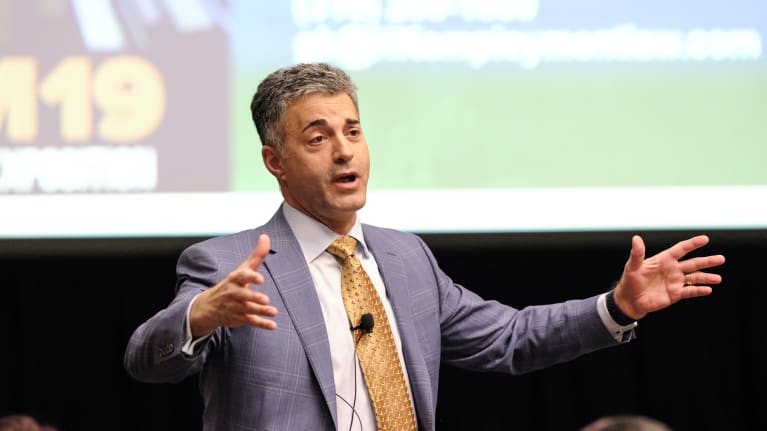Glen Kraemer Provides SHRM A New Perspective on Anti-Harassment Training

On June 24, 2019, Glen Kraemer spoke at the Society for Human Resource Management (SHRM) 2019 Annual Conference & Exposition in Las Vegas, Nevada. Glen’s presentation, Shaping Hearts, Minds…and Corporate Cultures: Effective Prevention Training In The #MeToo Era, was reprised in the following article on SHRM’s website, and has been republished with permission.
Treating the #MeToo Movement as an Opportunity to Create Better Workplaces
By Lisa Nagele-Piazza, J.D., SHRM-SCP
June 25, 2019
LAS VEGAS—In the wake of the #MeToo movement, many states have strengthened their anti-discrimination laws and developed more-robust workplace sexual-harassment-prevention training requirements. HR professionals and organizational leaders should treat the eruption of such mandates as an opportunity—not an obligation, said Glen Kraemer, an attorney with Hirschfeld Kraemer in Santa Monica, Calif.
Existing laws have failed to sufficiently deal with victims of workplace harassment, he said during a June 24 concurrent session at the Society for Human Resource Management 2019 Annual Conference & Exposition. So when employers are developing new policies and practices, they should “shed the ‘check-the-box’ compliance mentality and use new mandates as the catalyst for developing a meaningful, customized training curriculum,” he said. “Send a clear message to the workforce that your organization has an authentic commitment to a culture of respect that has no tolerance for abusive conduct.”
Sexual-Harassment Claims on the Rise
HR professionals and the federal government are seeing more sexual-harassment claims since the #MeToo movement went viral in October 2017. Thirty-six percent of HR professionals who responded to a 2018 SHRM survey said the number of sexual-harassment allegations they received increased between 2017 and 2018.
In fiscal year 2018, the Equal Employment Opportunity Commission (EEOC) received 7,609 sexual harassment charges—13.6 percent more than during the previous year—and recovered $56.6 million for victims of sexual harassment, according to the agency’s website.
“We cannot look back on last year without noting the significant impact of the #MeToo movement in the number of sexual-harassment and retaliation charges filed with the agency,” said EEOC Commissioner Victoria Lipnic.
But focusing on conduct that will meet the legal test for sexual harassment isn’t enough to eradicate such behavior from the workplace, Kraemer said.
For instance, if employers don’t address workplace bullying, they’re not fixing the gateway conduct that leads to harassment. “The low-level stuff that festers is actually the challenge,” he said.
Training Considerations
Conference attendee Kalandria Thompson, SHRM-CP, said she was hoping to find a new way to present sexual-harassment-prevention training that is modernized and relevant in light of the #MeToo movement. She is a human resource manager for Tuscaloosa Public Library in Alabama.
Kraemer said programs need to change hearts and minds. “If you’re relying on the law … it’s not going to get you there.”
Employers should move toward a more results-oriented training program that features fresh content and new instructional methods. The focus should be less on liabilities and how to avoid them, and more on the behaviors and communications that can create the perception of harassment and bullying, Kraemer said.
“You need to make training right for your culture,” he noted. Consider interviewing—or even auditioning—trainers to ensure that they will be sensitive to the employees’ needs and recognize where the audience is coming from.
“The trainer needs to understand and be able to respond to the challenges that might be presented in a given workplace without diminishing the importance of the content and message,” he said.
Even when their jurisdiction does not require it, employers should strive to train all employees, including nonmanagers. Creating a common vocabulary of respect—and a common understanding of behavioral expectations and reporting processes—will go a long way toward maintaining a positive workplace environment.
“The goal is to ensure that all employees have the knowledge and information necessary to feel safe in seeking solace and satisfaction of their grievances internally at your organization,” Kraemer noted.
Multistate Employer Policies and Programs
Employers who operate in more than one state or city may have to comply with several sexual-harassment-prevention training mandates. For instance, California employers have specific guidelines to follow, and while New York state and New York City requirements are similar, there are some nuances under each location’s law.
Employers should consider adopting the law of the location that is most robust in protecting the rights of employees, Kraemer said. For example, multistate employers with operations in California may incorporate the state’s broader definition of hostile work environment into their policies for all locations.
Employers don’t want to say that only California employees are going to be protected to a higher level. Having a consistent policy will send a clear message that the employer is committed to protecting all of its employees pursuant to the most stringent requirements, he said.
Reproduced with permission of Society For Human Resource Management (SHRM) via Copyright Clearance Center.
Glen Kraemer is managing partner of Hirschfeld Kraemer LLP’s Santa Monica office. He is passionately committed to keeping organizations in compliance with ever-evolving human resources regulations. For more information, please contact Glen at gk@hkemploymentlaw.com, or (310) 255-1800.





